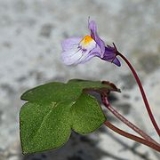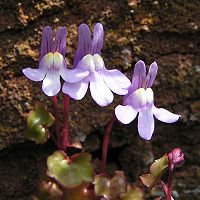
Cymbalaria
Encyclopedia
Cymbalaria is a genus of about 10 species of herbaceous
perennial plant
s previously treated in the family Scrophulariaceae
, but recently shown by genetic research to be in the much enlarged family Plantaginaceae
.
The genus is native to southern Europe
. It is closely related to the genera Linaria
and Antirrhinum
, differing in having creeping growth and flower
s borne singly rather than in dense erect spikes. The common name toadflax
is shared with Linaria and other related genera. The scientific name means "resembling a cymbal
" for the somewhat rounded leaves.
By far the best known species is Cymbalaria muralis (also called Ivy-leaved toadflax, and Kenilworth Ivy), native to southwest Europe. It has widely naturalised elsewhere and is commonly sold as a garden plant. C. muralis characteristically grows in sheltered crevices in walls and pathways, or in rocks and scree, making a trailing or scrambling plant up to 1 m long.

Herbaceous
A herbaceous plant is a plant that has leaves and stems that die down at the end of the growing season to the soil level. They have no persistent woody stem above ground...
perennial plant
Perennial plant
A perennial plant or simply perennial is a plant that lives for more than two years. The term is often used to differentiate a plant from shorter lived annuals and biennials. The term is sometimes misused by commercial gardeners or horticulturalists to describe only herbaceous perennials...
s previously treated in the family Scrophulariaceae
Scrophulariaceae
Scrophulariaceae, the figwort family, are a family of flowering plants. The plants are annual or perennial herbs with flowers with bilateral or rarely radial symmetry. Members of the Scrophulariaceae have a cosmopolitan distribution, with the majority found in temperate areas, including...
, but recently shown by genetic research to be in the much enlarged family Plantaginaceae
Plantaginaceae
Plantaginaceae Juss. or plantain family, are a family of flowering plants in the order Lamiales. The type genus is Plantago L..In older classifications it used to be the only family of the order Plantaginales, but numerous phylogenetic studies, summarized by the Angiosperm Phylogeny Group, have...
.
The genus is native to southern Europe
Europe
Europe is, by convention, one of the world's seven continents. Comprising the westernmost peninsula of Eurasia, Europe is generally 'divided' from Asia to its east by the watershed divides of the Ural and Caucasus Mountains, the Ural River, the Caspian and Black Seas, and the waterways connecting...
. It is closely related to the genera Linaria
Linaria
Linaria is a genus of about 100 species of herbaceous annuals and perennials that was traditionally placed in the figwort family Scrophulariaceae. Due to new genetic research, it has now been placed in the vastly expanded family Plantaginaceae...
and Antirrhinum
Antirrhinum
Antirrhinum is a genus of plants commonly known as snapdragons from the flowers' fancied resemblance to the face of a dragon that opens and closes its mouth when laterally squeezed...
, differing in having creeping growth and flower
Flower
A flower, sometimes known as a bloom or blossom, is the reproductive structure found in flowering plants . The biological function of a flower is to effect reproduction, usually by providing a mechanism for the union of sperm with eggs...
s borne singly rather than in dense erect spikes. The common name toadflax
Toadflax
Toadflax is the English name of several related genera of plants in the family Plantaginaceae and Scrophulariaceae:*Anarrhinum*Antirrhinum *Chaenorhinum*Cymbalaria*Linaria*Misopates*Nuttallanthus...
is shared with Linaria and other related genera. The scientific name means "resembling a cymbal
Cymbal
Cymbals are a common percussion instrument. Cymbals consist of thin, normally round plates of various alloys; see cymbal making for a discussion of their manufacture. The greater majority of cymbals are of indefinite pitch, although small disc-shaped cymbals based on ancient designs sound a...
" for the somewhat rounded leaves.
By far the best known species is Cymbalaria muralis (also called Ivy-leaved toadflax, and Kenilworth Ivy), native to southwest Europe. It has widely naturalised elsewhere and is commonly sold as a garden plant. C. muralis characteristically grows in sheltered crevices in walls and pathways, or in rocks and scree, making a trailing or scrambling plant up to 1 m long.


